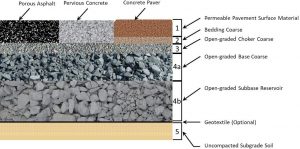To take full advantage of permeable pavement, a green alternative to traditional concrete or asphalt pavers that collect and filter stormwater runoff, infrastructure planners must take many site-specific factors into account.
A new guide to permeable pavements written by researchers from the University of Florida Institute of Food and Agricultural Sciences (UF–IFAS; Gainesville) helps developers, engineers, landscape architects, and other planners answer such questions as:
- How much traffic can a permeable pavement installation withstand before cracking or splintering?
- At what depth should the pavement be installed to ensure seasonal changes to the water table do not interfere with its function?
- Does the pavement’s setting call for building its surface out of permeable interlocking concrete pavers or plastic reinforcing grids?

Permeable pavements can withstand foot and vehicle traffic while also enabling rain to infiltrate the underlying soil rather than generating runoff. A new guide to permeable pavements written by University of Florida Institute of Food and Agricultural Sciences (UF–IFAS; Gainesville) researchers details how to create well-functioning permeable pavement systems. Photo courtesy of Eban Bean/UF–IFAS.
The guide covers permeable pavement fundamentals, such as siting, design, installation, and maintenance, as well as broader considerations including qualifying for green building certification programs, meeting regulatory standards, and funding and financing strategies.
“I think the best reason for developers to use permeable pavement is the growing need to better manage stormwater runoff and the pollutants, rather than running off into our water ways and impairing our water bodies,” said Eban Bean, UF–IFAS agricultural engineering professor and co-author of the guide, in a release.
Permeable or non-permeable?
The guide also provides an honest assessment of the pros and cons of permeable pavement versus traditional impervious pavers. For example, permeable pavements often are more expensive than concrete and asphalt and require routine maintenance to prevent sediment clogging. However, by reducing or eliminating requirements for larger, costlier gray stormwater infrastructure, permeable pavements can, in many cases, help achieve overall cost savings while meeting regulatory requirements.
Permeable pavements are ideal for roadways with infrequent vehicular traffic, such as residential feeder streets, low-intensity commercial parking lots, roadway shoulders, and bicycle paths, according to the guide. Conventional pavements are better for areas with heavy traffic or roadways with many twists and turns, as too many curves increase the chance that permeable pavement will shift, crack, or splinter.
The two pavement types also can work in tandem, the guide explains. By installing impervious pavement in strategic areas around the perimeter of permeable pavers, infrastructure planners can direct runoff toward the permeable installation to capture more stormwater.
A resource for green infrastructure education
While some parts of the UF-IFAS guide are specific to Florida regulations, most of its information will be of use to any water quality professional interested in permeable pavement.
Basic design guidelines are applicable in various climates and topographies. For example, recommendations in the document include
- ensuring that at least 0.6 m (2 ft) of space remains between the bottom of a permeable pavement system and the underlying aquifer’s seasonal-high water table;
- designing the system based on elevation and precipitation, such that runoff exits the system within 24 to 72 hours; and
- locating permeable pavement systems far away from sites where any hazardous materials run the risk of spilling and contaminating soil and groundwater supplies.

The UF–IFAS guide covers permeable pavement fundamentals, such as siting, design, installation, and maintenance, as well as broader considerations including qualifying for green building certification programs, meeting regulatory standards, and funding and financing strategies. Photo courtesy of the American Society of Civil Engineers (Reston, Va.).
The guide is particularly useful in green infrastructure training courses, which are increasingly held in the U.S. as nature-friendly designs like permeable pavements call for a new skillset not typically held by water professionals.
“Our hope is that with a better understanding of the technology … people will incorporate low-impact practices into development – where it is appropriate – to more effectively address impacts of stormwater runoff compared to the conventional approach of stormwater ponds and infiltration basins,” Bean said.
Read the full guide for more information about permeable pavements.




